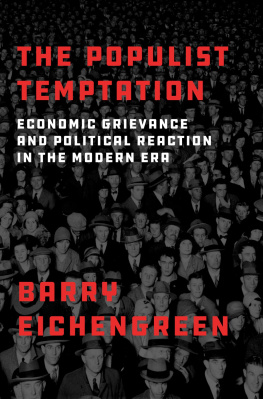
Populism is a new phenomenon but also a very old one. This is most visibly true in the United States, where what is referred to as the Populist Revolt occurred in the nineteenth century. But it is also true of Europe, where charismatic leaders with anti-establishment, authoritarian, and nationalist tendencies, from Benito Mussolini to Ioannis Metaxas, captured the popular imagination, or at least the levers of power, in the 1920s and 1930s. Whether these specific individuals should be identified as populist is debatable. Charisma, for one thing, is in the eye of the beholder (as Max Weber reminded us). More fundamentally there is the question of whether populism as a concept is well defined. But to the extent that there is something afoot in the United States, the United Kingdom, and Europe that involves the reaction of voters against the political establishment, nationalist and racialist sentiment directed against foreigners and minorities, and a yearning for forceful, charismatic leadership, this something, whatever we call it, is not new.
By looking back at the history of the United States and Europe I hope to identify the economic, social, and political circumstances under which populism takes hold and the policies that most effectively combat it. I seek to determine why radical political movements with anti-elite, authoritarian, and nativist tendencies succeed at some times but not others. I hope to understand why in some cases the center held, while in others political extremists carried the day.
Historical comparisons are powerful but perilous. A focus on extreme cases lends itself to exaggeration, and parallels can be overdrawn. Today is not the 1930s. By acknowledging differences and considering instances where a populist reaction was contained as well as those where populist leaders and movements usurped power, I hope to avoid the worst pitfalls.
The answers matter. The characteristic economic policies of populist leaders are damaging and destructive, and the impact of populists on political institutions is corrosive. The attitudes they animate bring out the worst in their followers. Populism arrays the people against the intelligentsia, natives against foreigners, and dominant ethnic, religious, and racial groups against minorities. It is divisive by nature. It can be dangerously conducive to bellicose nationalism.
The history recounted here suggests that populism is activated by the combination of economic insecurity, threats to national identity, and an unresponsive political system, but that it can be quelled by economic and political reforms that address the concerns of the disaffected. A first step is for policymakers to do what they can to reinvigorate economic growth, giving young people hope that their lives will be as good as those of their parents and older people a sense that their lifetime of labor is respected and rewarded. Populist revolts rarely arise in good economic times, in other words.
Equally important is that the fruits of that growth be widely shared and that individuals displaced by technological progress and international competition are assured that they have social support and assistance on which to fall back. Assuring them starts with acknowledging that there are losers as well as winners from market competition, globalization, and technical change, something that economists are taught at an early age but which they have a peculiar tendency to forget. It continues with acknowledging that economic misfortune is not always the fault of the unfortunate. It concludes by putting in place programs that compensate the displaced and by providing education, training, and social services to help individuals adjust to new circumstances. This is not a novel formula. But if its elements are commonplace, they are no less important for that.
Commonplace, however, is not the same as straightforward. Modern societies show disturbingly little capacity to respond in this way. They struggle to develop a political consensus around the desirability of implementing and, no less important, adequately financing programs that compensate the displaced and help them adjust to new circumstances. In turn this points to a second source of populist disaffection, namely, the dysfunctionality of the political system. Here the relevant institutions include the electoral system, the legislature, the civil service, and the courts, but also civil society and the Fourth Estate. Their structure shapes the responsiveness of government, which is the ultimate measure of whether the citizenry has a voice. Political institutions are also a key ingredient of political stability and hence of the capacity of society to pursue policies making for growth and an equitable distribution of its fruits. Suitably designed, they give voters and candidates for office an incentive to move to the political middle. They help cultivate a social and political consensus for prevailing policies, which in turn makes for stability, economic and political both. But those institutions can also provoke dissatisfaction and incite a political reaction when they fail to deliver the goods.














